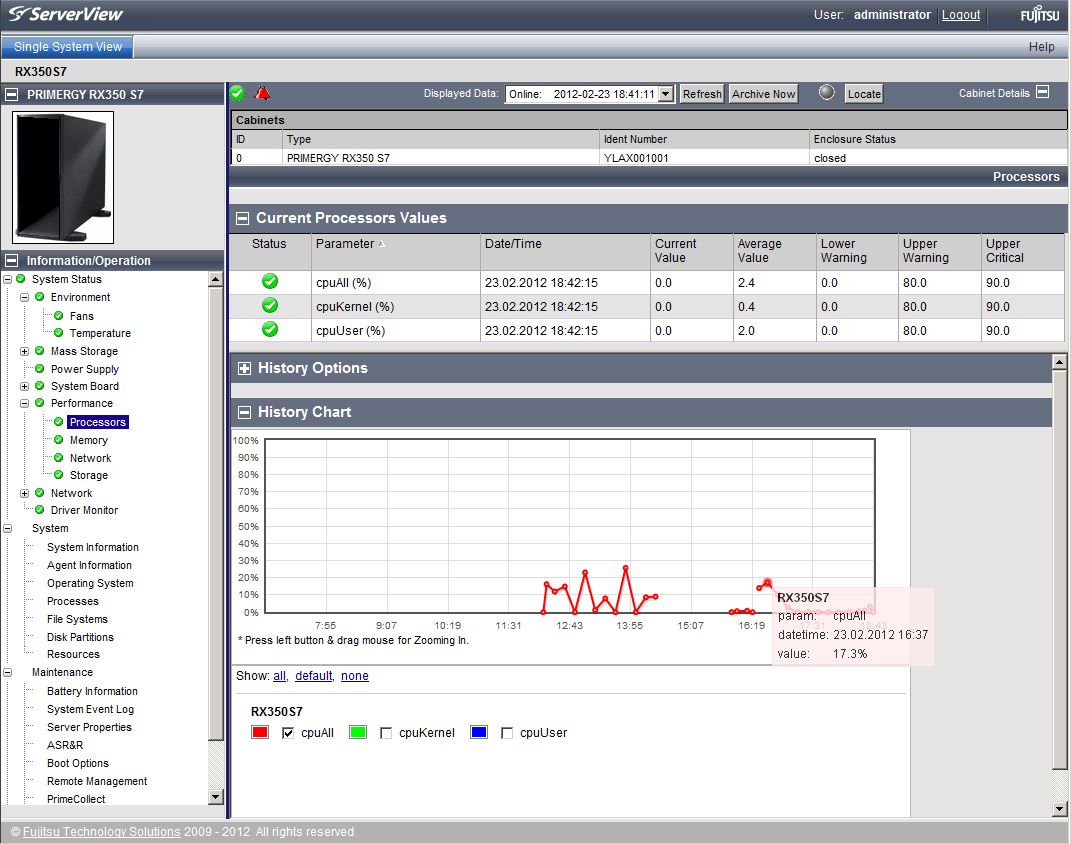Fujitsu Primergy RX350 S7 review
Fujitsu’s new RX350 S7 neatly fills a gap in its Primergy server range and showcases Intel’s latest Xeon E5-2600 processors. In this exclusive review, Dave Mitchell looks at this highly expandable system and its modular features.
Fujitsu’s new Primergy RX350 S7 is a solid choice as a server consolidation platform and for running critical database applications. Its modular design gives it a massive expansion potential and although the system came with the lower specified 6-core E5-2600 CPUs, it still represents very good value.

No less than ten PCI-e Gen3 slots are available and Fujitsu is obviously targeting high-performance graphics applications as two of them can handle NVIDIA's Tesla C2075 GPU cards, with 448 cores apiece.
The RAID card takes another slot, but that still leaves seven others free although the new C600 Patsburg architecture requires both CPU sockets to be populated if all are to be activated.

Fujitsu's ServerView software is designed to manage multiple systems and provides useful CPU utilisation charts.
The Primergy RX350 S7 is a much-needed addition to the Primergy range, with its combination of lower-cost dual CPU sockets, high storage capacity and plenty of expansion potential. It's also well designed, offers good remote management tools and has commendably low power consumption.
Verdict
Fujitsu’s new Primergy RX350 S7 is a solid choice as a server consolidation platform and for running critical database applications. Its modular design gives it a massive expansion potential and although the system came with the lower specified 6-core E5-2600 CPUs, it still represents very good value.
Chassis: 4U rack CPU: 2x 2GHz Xeon E5-2620 Memory: 32GB DDR3 expandable to 768GB Storage: 2x 146GB Fujitsu SFF SAS 6Gb/sec hot-swap hard disks (max. 24) RAID: Fujitsu SAS CTRL 5/6 RAID PCI-e with 512MB cache Array support: RAID 0, 1, 10, 5, 50, 6, 60 Expansion: 10x PCI-e Gen3 slots (with dual CPUs) Network: 4x Gigabit Power: 2x 800W hot-plug supplies (max. 4) Management: Fujitsu iRMC S3 with 10/100 port Software: Fujitsu ServerView Suite software Warranty: 3-year on-site NBD
Sign up today and you will receive a free copy of our Future Focus 2025 report - the leading guidance on AI, cybersecurity and other IT challenges as per 700+ senior executives
Dave is an IT consultant and freelance journalist specialising in hands-on reviews of computer networking products covering all market sectors from small businesses to enterprises. Founder of Binary Testing Ltd – the UK’s premier independent network testing laboratory - Dave has over 45 years of experience in the IT industry.
Dave has produced many thousands of in-depth business networking product reviews from his lab which have been reproduced globally. Writing for ITPro and its sister title, PC Pro, he covers all areas of business IT infrastructure, including servers, storage, network security, data protection, cloud, infrastructure and services.
-
 ‘1 engineer, 1 month, 1 million lines of code’: Microsoft wants to replace C and C++ code with Rust by 2030 – but a senior engineer insists the company has no plans on using AI to rewrite Windows source code
‘1 engineer, 1 month, 1 million lines of code’: Microsoft wants to replace C and C++ code with Rust by 2030 – but a senior engineer insists the company has no plans on using AI to rewrite Windows source codeNews Windows won’t be rewritten in Rust using AI, according to a senior Microsoft engineer, but the company still has bold plans for embracing the popular programming language
By Ross Kelly Published
-
 Google drops $4.75bn on data center and energy firm Intersect
Google drops $4.75bn on data center and energy firm IntersectNews The investment marks the latest move from Google to boost its infrastructure sustainability credentials
By Nicole Kobie Published
-
 OpenAI says prompt injection attacks are a serious threat for AI browsers – and it’s a problem that’s ‘unlikely to ever be fully solved'
OpenAI says prompt injection attacks are a serious threat for AI browsers – and it’s a problem that’s ‘unlikely to ever be fully solved'News OpenAI details efforts to protect ChatGPT Atlas against prompt injection attacks
By Nicole Kobie Published
